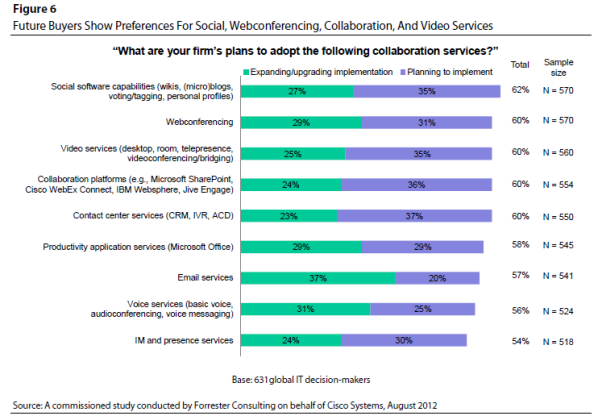A study by Forrester Consulting (November 2012) concluded that employees will be at the heart of the push to adopt collaboration services. It seems that 22% of IT professionals already use unauthorized websites or web services for help in their jobs, and 8% use at least four of these websites.
These findings build on a noted trend: the Cloud will act as an enabler and accelerator of collaboration services adoption. In fact, companies are increasingly replacing or adding to their existing collaboration technologies with cloud-based collaboration solutions.
It’s thus crucial to track the impact of these new uses to ensure that everyone at a company uses the same collaboration tools.
In this task, IS heads and departments have a critical role to play. According to Forbes, only 60% of companies are in the process of planning or implementing a collaboration services adoption program. Until now, IT divisions have offered different communications tools on separate devices (voice and/or video). But the use of mass market tools in the workplace has caused a full-scale revolution in the IT landscape. Terminals are now multi-platform, multi-OS and capable of offering centralized management of all types of collaboration services (voice / video / presence / instant messaging / web collaboration).
how will companies benefit?
The same Forbes report indicates that cloud-based collaboration services provide companies and their subsidiaries with communications tools that can significantly improve business processes in terms of the following:
- innovation: to reduce time-to-market for products, for example
- efficiency: to facilitate tasks for mobile workers
- growth: to improve customer relations by providing easier access to expertise
- flexibility: to help companies adapt to new developments in their environment (internal and external growth, diverse suppliers and customers) and their markets (increased global competition, accelerated innovation, etc.)
The ability to adapt to change is essential for maintaining any decisive edge over the competition. For this reason, implementing efficient collaboration tools are crucial to a company’s long-term success. Concrete examples of this abound since collaboration is the backbone of action at every company.
equipment plans – collaboration services

For more information download the Forrester Consulting white paper.
the cloud: a growing delivery model (Forrester extract)
The Forrester Consulting report argues that:
- over the next six years, cloud-delivered collaboration services will grow by an average of 14% per year; by 2018, they will represent 35% of the total collaboration services market,
- the pay-as-you-go cloud delivery model will drive the worldwide growth of collaboration services,
- videoconferencing services will grow the fastest.
The results of these reports are impressive. I see these changes taking place every day as I interact with customers. It’s now essential for all companies to adapt their services, and most have already implemented or plan to implement a strategy to adapt these new market trends to meet their needs.
Considering the difficulties in our professional environments, cloud-based collaboration services are of key importance not only for the technology, but also for the agility and flexibility they offer. In concrete terms, this will enable companies to adapt their collaboration services to:
- employee jobs and needs (assistants, mobile employees, experts, etc.),
- changes within the company, from upgrades to keep pace with organic and external growth to downgrades during corporate restructuring.
When combined with per-user, pay-as-you-go billing, these solutions provide high financial predictability, require no capital expenditure and optimize a company’s organizational structure. All this confirms that cloud-based collaboration services will help companies adapt to new changes in their businesses.
François Moïse
http://collaborationblog.cisco.fr
This post was originally published in French here.
image: © NLshop - Fotolia.com

I've been selling IT solutions for more than 20 years. After working at Alcatel in sales, I joined Cisco in 1997. I've held multiple sales management functions before becoming Director of Unified Communications and Collaboration solutions in 2008.